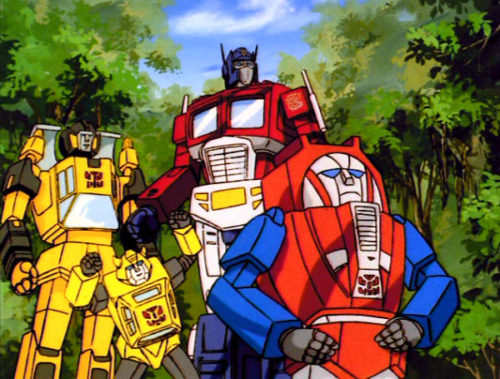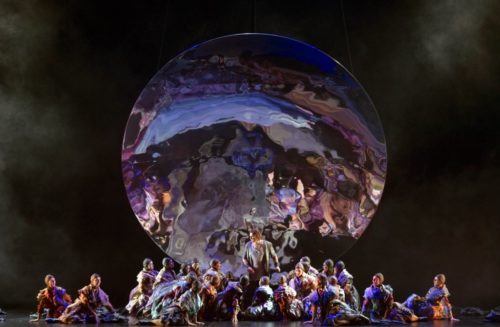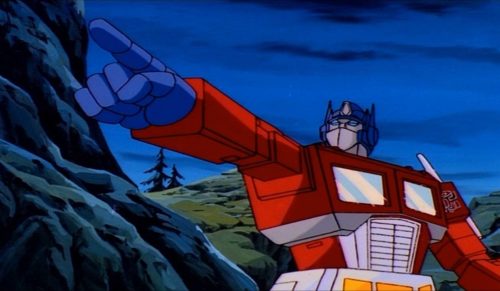
This one comes to us from Jeremiah Lawson, the first in a three-part series!
First and foremost, play is self-presentation.
– Hans-Georg Gadamer, Truth and Method
About forty years ago an animated program began that helped revolutionize the way some Americans enjoyed and thought about popular culture. Thanks to changes in FCC regulations during the Reagan administration, it was possible to broadcast animated series based on toys that would then be advertised during intermissions near or during the show. The more famous examples were associated with Hasbro and can be easily identified: G. I. Joe, My Little Pony, and Transformers. Transformers, particularly, has had some kind of television series going in every decade since.
 To discuss Transformers, one must remember: these aren’t just films, but films about toys children played with. A Transformers film, on a screen big or small, was a story that would be presented to an audience that had usually pre-invested in the experience by, at some point, having played with the toys. Most cinema as art is a kind of vicarious living. What separates the cinema derived from toy lines is that flesh-and-blood children play with the toys and through that they bring their own lives into the art.
To discuss Transformers, one must remember: these aren’t just films, but films about toys children played with. A Transformers film, on a screen big or small, was a story that would be presented to an audience that had usually pre-invested in the experience by, at some point, having played with the toys. Most cinema as art is a kind of vicarious living. What separates the cinema derived from toy lines is that flesh-and-blood children play with the toys and through that they bring their own lives into the art.
It was not until the invention of the internet and social media that self-identifying grown-ups began to discover the kind of immersive play that is essential to understanding how these Hasbro toy lines could inspire films and how generations of fans could retain their investment in such seemingly ridiculous stories. It’s not that difficult, though. Anyone who can understand the immersive experience of using social media to define themselves through the play of internet activity can, in principle, understand the kind of childhood play that went into Hasbro properties that have, generations since the 1980s, become the films we may or may not want to see.
The synergy of TV show and film and comic book and toy as part of playtime is necessary to grasp the significance of what makes Transformers what it is, and also what makes Star Wars what it is, since this pop cultural neo-animistic religion of toys was, if anything, pioneered by George Lucas and Kenner before Hasbro got on board.
At no less than seven films, Transformers is the brand that has had the most pervasive pop culture presence in mass media terms, thanks to the Hasbro toy lines. Many film critics might wish there were no film franchises based on Hasbro toy lines but, of course, we don’t live in that world. Yet mainstream film criticism in our time and place has shown little interest in understanding a world in which there can be seven Transformers movies.
In order to start understanding how we got to the point where there are seven Transformers films, we need to go back a couple of centuries to the opera composer and musical thinker Richard Wagner. The path to a Hollywood cinematic juggernaut inspired by a mythology built around imported toy lines goes back to German revolutionary idealists, who sought to recover a fusion of the arts that was imagined to exist in ancient Greece. As Wagner writes:
The deeds of gods and men, their sufferings, their delights, as they,—in all solemnity and glee, as eternal rhythm, as everlasting harmony of every motion and of all creation, —lay disclosed in the nature of Apollo himself; here they became actual and true. For all that in them moved and lived, as it moved and lived in the beholders, here found its perfected expression; where ear and eye, as soul and heart, lifelike and actual, seized and perceived all, and saw all in spirit and in body revealed; so that the imagination need no longer vex itself with the attempt to conjure up the image. Such a tragedy-day was a Feast of the God; for here the god spoke clearly and intelligibly forth, and the poet, as his high priest, stood real and embodied in his art-work, led the measures of the dance, raised the voices to a choir, and in ringing words proclaimed the utterances of godlike wisdom. Such was the Grecian work of art; such their god Apollo, incarnated in actual, living art; such as the Grecian people in its highest truth and beauty. (Art and Revolution, translation William Ashton Ellis)
When Hasbro developed a mythology for toys that made them Autobots and Decepticons, the stage was set for a universe-spanning saga of “the deeds of gods and men.”
Wagner believed that an ancient fusion of Art and Religion had existed in Greece and was watered down by the Romans and destroyed by Christianity. It was not until Christianity ossified into neo-Roman Christendom that Wagner believed Christianity began to produce art worth talking about and that apart from the art of music, Christianity was in many ways the enemy of real Art. But to the extent that there was something good about Christianity, it was the job of Art and the Artist to salvage whatever good there was in myths:
One might say that where Religion becomes artificial, it is reserved for Art to save the spirit of religion by recognising the figurative value of the mythic symbols which the former would have us believe in their literal sense, and revealing their deep and hidden truth through an ideal presentation. Whilst the priest stakes everything on the religious allegories being accepted as matters of fact, the artist has no concern at all with such a thing, since he freely and openly gives out his work as his own invention. But Religion has sunk into an artificial life, when she finds herself compelled to keep on adding to the edifice of her dogmatic symbols, and thus conceals the one divinely True in her beneath an ever growing heap of incredibilities commended to belief. Feeling this, she has always sought the aid of Art; who on her side has remained incapable of higher evolution so long as she must present that alleged reality of the symbol to the senses of the worshipper in form of fetishes and idols,— whereas she could only fulfil her true vocation when, by an ideal presentment of the allegoric figure, she led to apprehension of its inner kernel, the truth ineffably divine. To see our way clear in this, we should have most carefully to test the origin of religions. These we must certainly deem the more divine, the simpler proves to be their inmost kernel. (Religion and Art)
 If you want to see how Wagner imagined Art could do better for Religion what Religion had long failed to achieve, you can go watch his Ring tetralogy, his opera Parsifal, or some of his other operas.
If you want to see how Wagner imagined Art could do better for Religion what Religion had long failed to achieve, you can go watch his Ring tetralogy, his opera Parsifal, or some of his other operas.
In David Roberts’ summation of the means and ends of “the total work of art” as imagined by 19th-century European revolutionary thinkers, the goal was to create through the arts a new kind of civil religion that would supplant or improve upon what, if anything, was considered positive from medieval Christendom but to introduce a new foundation on more optimistic humanistic grounds.
In European art, the total work of art was intended to have a revolutionary role. Yet the total work of art (or we could call it a brand or the branded fusion of arts and media around a central idea or cult) in American cultural terms could be thought of as affirmative. While in the European cultural imagination, great art is often tragic, American popular art is generally comic, or perhaps we could say anti-tragic.
Nothing may reveal the stark contrast between 19th-century European and 21st-century American iterations of the total work of art better than Wagner’s operatic cycle, which ends with the death of the gods and the burning of the world as tragic redemption. American filmmakers, on the other hand, can’t resist making movie after movie in which Americans save the world (or the universe, when applicable). It’s easier for Americans to imagine stories in which we’re saving space-time as we know it than to imagine a world in which Americans won’t save it. As Tony Stark puts it in the first Avengers movie, if the superheroes in the Marvel films can’t save the world, they can at least avenge it. American popular film being what it so often is, why not insist on doing both?
 Yet even in America there are examples of a utopian, revolutionary Art Work of the Future in the Wagnerian style; a unified story of the human condition that involves all media and tells a story of humanity that is meant to embody, anticipate, and in some way catalyze the ideal human society it depicts. The quintessence of the Wagnerian ideal for the arts has been with us for generations, but how often do you hear film critics and film historians talk about Star Trek? When 19th-century European thinkers and artists envisioned a revolutionary artwork that would unify humanity and lead it into a new and brighter future, the idea was that this would be through the poetry of Mallarmé, the novels of Balzac, the music of Scriabin, the plays of Shakespeare, or the operas of Wagner. It definitely would not be The Wrath of Khan or The Empire Strikes Back, or least of all Michael Bay’s Transformers films!
Yet even in America there are examples of a utopian, revolutionary Art Work of the Future in the Wagnerian style; a unified story of the human condition that involves all media and tells a story of humanity that is meant to embody, anticipate, and in some way catalyze the ideal human society it depicts. The quintessence of the Wagnerian ideal for the arts has been with us for generations, but how often do you hear film critics and film historians talk about Star Trek? When 19th-century European thinkers and artists envisioned a revolutionary artwork that would unify humanity and lead it into a new and brighter future, the idea was that this would be through the poetry of Mallarmé, the novels of Balzac, the music of Scriabin, the plays of Shakespeare, or the operas of Wagner. It definitely would not be The Wrath of Khan or The Empire Strikes Back, or least of all Michael Bay’s Transformers films!
Yet what separates Wagner’s Ring cycle from, say, Marvel’s films, which culminate in Infinity War and Endgame? The answer seems to be the literary pedigree from which creators draw inspiration. Wagner drew upon Schopenhauer, Feuerbach, ancient Norse and German pagan literature, and highbrow German philosophers. Star Wars drew upon ideas more in the vein of James Frazer and Joseph Campbell, a second-hand Jungianism, as well as 20th-century cinema. Let’s consider, then, that in terms of global box office, the Aronofsky film mother! was beaten by the My Little Pony movie in 2017. The paradox and irony of cinema is that the Aronofsky film is the real blink-and-you-missed-it fad film compared to the Hasbro toy lines that spawned a dozen movies and are intergenerational, international cultural juggernauts, whether the non-human protagonist is Twilight Sparkle or Optimus Prime.
But as much as fans of the 1986 animated Transformers film may insist otherwise, the success of that film more or less assured that something like the Michael Bay films were likely to happen. The 1986 film ended and began two eras in the Transformers mythos with simultaneously tragic and triumphant narratives. As popular culture cults go, the 1986 Transformers film is arguably a foundation stone in a religion of toys. And that religion is as American as apple pie and as popular as Star Wars, but not quite the same as either of those things.
For more contemporary takes on the total work of art in European and American modernism the following books are immensely helpful reads:
The Ring of Truth by Roger Scruton (on Wagner’s ideas about art and humanity)
The Total Work of Art: From Bayreuth to Cyberspace by Matthew Wilson Smith
Art and Enlightenment: Aesthetic Theory after Adorno by David Roberts
Dialectic of Romanticism by Peter Murphy and David Roberts
particularly The Total Work of Art in European Modernism by David Roberts
and if you read German there’s a big monograph on the total work of art in European modernism by Roger Fornoff, but I don’t read German myself.


COMMENTS
Leave a Reply












